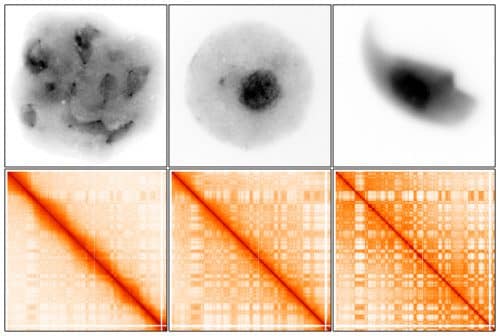Every day, hundreds of millions of sperm cells are created in the human body. One of the critical stages in the formation of sperm cells is meiosis (reduction division). During meiosis a drastic process of reorganization of the DNA packaging takes place. In this process the chromosomes are compressed in preparation for the reduction division. Moreover, the compressed chromosomes exchange different segments between them and thus increase the genetic diversity * Joint article by researchers from the Technion and the Cincinnati Children's Hospital

Researchers from the Rappaport Faculty of Medicine at the Technion present new discoveries about the organization of DNA during sperm formation and its implications for the future organism. The research published yesterday in the journal Nature Structural & Molecular Biology was conducted by Dr. Noam Kaplan together with the student (master's degree) Haya Khoury and their colleagues at the Children's Hospital in Cincinnati. The research team in Cincinnati was led by Prof. Stoshi Namakawa and research student Kris Elwatham.
The DNA in the living cell is packaged, with the proteins associated with it, in a molecular complex called chromatin. Although the chromatin is apparently only used as a "package" for the genetic information contained in the DNA, the way in which the DNA is packaged has a significant effect on the systems that are activated in the cells. Too tight packaging of the DNA, for example, could hide it from the biological mechanisms that are supposed to read and decode it, thereby silencing certain genes.
In the current study, the organization of DNA in chromatin was examined during spermatogenesis (spermatogenesis) - the development of the sperm. Spermatogenesis is a much-studied process, but due to technological limitations, the form of DNA packaging in this process has not yet been deciphered in detail. The researchers have now succeeded in this challenge using an innovative technology called Hi-C, which combines a biological experiment and computational analysis and thus makes it possible to estimate the spatial organization of the DNA with great precision.
Every day, hundreds of millions of sperm cells are created in the human body. One of the critical stages in the formation of sperm cells is meiosis (reduction division). During meiosis a drastic process of reorganization of the DNA packaging takes place. In this process the chromosomes are compressed in preparation for the reduction division. Moreover, the compressed chromosomes exchange different segments and thus increase the genetic diversity.
The Israeli-American research team was able to isolate mouse sperm cells at the beginning of meiosis, when the chromosomes are compressed, and then measure the distances between millions of pairs of points in the DNA. The researchers discovered that the spatial structure of the chromatin gradually strengthens during the different phases of meiosis, until it reaches maximum strength in the adult sperm. They estimate that the aforementioned XNUMXD organization allows the sperm cells to activate many and varied genes during meiosis, thus giving these cells the ability to divide into specialized cells (skin, muscle, etc.) after fertilization. According to Dr. Kaplan, "In the future we intend to use these methods to understand how the spatial structure of the genome may affect fertility."
The research was conducted with the assistance of the American Institutes of Health (NIH), the Azrieli Foundation and the Taub Fellowship.
Dr. Noam Kaplan joined the faculty of the Rappaport Faculty of Medicine at the Technion in 2016, and here he established an interdisciplinary laboratory to map the spatial structure of the genome and to study its effect on the activity of the genome in health and disease.
Haya Hori completed a bachelor's degree in biology at the Technion and is currently studying for a master's degree in medical sciences at the Technion.

4 תגובות
Lagadi and Bat-ya
Your words are fundamentally wrong:
1]. A woman is not a person. A woman is Eve.
2]. Does the matter of the cat belong to us? Maybe.
After they finish investigating the human, they will also investigate cats and find out...
…that there are no such big differences.
Capricorn, you are not petty.
While reading I thought of writing a very similar comment.
You did the job for me.
So thanks.
It has already been written on this site, many times, that in a serious scientific article one should be precise in the details.
"Hundreds of millions of sperm cells are created in the human body every day"
Call me petty, but:
1. A woman is also a person, and sperm cells are not formed in her
2. A cat is not a person, and sperm cells are formed in it
Is there a similar study on the development of an egg in a female and not inside an ovary?